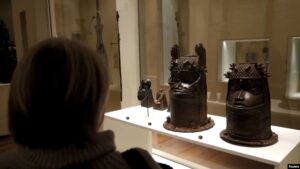


1. laboratory (n)
a room or building with scientific equipment for doing scientific tests or for teaching science, or a place where chemicals or medicines are produced
2. site (n)
a place where something is, was, or will be built, or where something happened, is happening, or will happen
3. spear (n)
a weapon consisting of a pole with a sharp, usually metal, point at one end, that is either thrown or held in the hand
4. burial (n)
the act of putting a dead body into the ground, or the ceremony connected with this
5. archaeologists (n)
someone who studies the buildings, graves, tools, and other objects of people who lived in the past
6. assumed (v)
to accept something to be true without question or proof
7. prehistoric (adj)
describing the period before there were written records
Stone Age Women Hunted Big Game, Study Finds

In the Stone Age Americas, a woman’s place may have been on the hunt, a new study reports.
The study has archaeologists rethinking ideas about gender roles in prehistoric hunter-gatherer cultures. But some scientists are not so sure about the results.
Archaeologists involved in the research found the remains of a young woman at a 9,000-year-old burial site in Peru. She is buried with what appears to be a complete set of big-game hunting tools: spear points, scrapers, blades and more. “Big-game hunting” means the hunting of very large animals.
Researchers could not tell the individual’s sex at the place where the remains were found. “We all just assumed it was a dude” or male, said University of California Davis archaeologist Randy Haas.
But after studying the remains back at a laboratory, scientist Jim Watson of the University of Arizona said, “I think ‘he’ is a ‘she.'”
In nearly every hunter-gatherer culture studied, big-game hunting is done almost always by men. Scientists had guessed that, for the most part, that is how it has always been.
So, was this a special case? Or were prehistoric women hunters more common than thought? These are hard questions to answer because these kinds of sites are hard to find.
However, scientists in those studies did not identify many of these women as hunters. Haas notes that at some other sites, the tools were described not as hunting tools but as tools for preparing food or clothing, which were considered women’s work.
Resource: https://learningenglish.voanews.com/a/stone-age-women-hunted-big-game-study-finds/5654247.html

- What did you think when you read the headline?
- How do you think the early humans in the hunter-gatherer society choose their leaders?
“We have progressed from the stone age and moved on to the age of stone hearted people”
Amit Abraham













